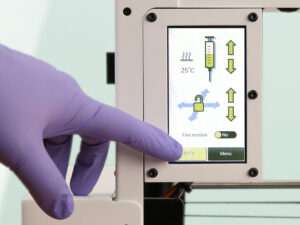LulzBot Releases It’s First Bioprinter
Bioprinting is revolutionizing the way 3D printed tissues can be used to mimic in vivo conditions. The fields of regenerative medicine, pharmaceutical development, and cosmetic testing are benefiting from this technological disruption, enabling researchers and companies to better predict efficacy and toxicology of potential drugs early on  in the drug discovery process. But it’s no wonder this technology is so enticing, since bringing a new drug to market, with current methods, could cost $350 million dollars and can take more than a decade from start to finish. On the North American front, Colorado-based manufacturer Aleph Objects, the developer behind the LulzBot 3D Printers, announced today a new open-source bioprinter: the LulzBot Bio.
in the drug discovery process. But it’s no wonder this technology is so enticing, since bringing a new drug to market, with current methods, could cost $350 million dollars and can take more than a decade from start to finish. On the North American front, Colorado-based manufacturer Aleph Objects, the developer behind the LulzBot 3D Printers, announced today a new open-source bioprinter: the LulzBot Bio.
After almost ten years of manufacturing 3D printers, LulzBot finally decided to move into the bioprinting market. The new machine, which is now available for pre-order on the site and will begin shipping in November, enables 3D printing with materials such as unmodified collagen, bioinks, and other soft materials, and is the company’s first-ever Fluid Deposition Fabrication (FDF) 3D printer. FDF is a newfangled name for the FRESH process which we wrote about here and here. According to LulzBot, unlike its pneumatic counterparts, the Bio’s syringe pump system allows for precise stopping and retraction, preventing unintentional extrusion and stringing while printing intricate models, like vasculature.
The printer has a Free Software design that removes proprietary restrictions, providing, what the company considers, a versatile platform for innovation that grows with everchanging discoveries and advancements. LulzBot reports a commitment to freedom of design in general, developing machines that come with freely licensed designs, and specifications, allowing for modifications and improvements to both software and hardware. In this respect, they have partnered with organizations, such as the Open Source Hardware Association, Free Software, and Libre Innovation. The Bio’s free software and open hardware design give researchers the ability to innovate together, letting the machine be easily adjusted for new materials and processes.
“For researchers, you don’t know what materials or processes you’ll be using in six months, let alone one year from now, so you need hardware that can be adjusted quickly and easily, without proprietary restrictions,” said Grant Flaharty, CEO and President of Aleph Objects.
The LulzBot Bio comes with nearly everything needed to start bioprinting right away, including extensively tested, preconfigured material profiles in Cura LulzBot Edition, the recommended software for the LulzBot printers; Petri dishes; Life Support gel (by FluidForm); alginate, and tools. It also enables printing with unmodified collagen, something that has proven extremely difficult and is considered one of the most promising materials for bioprinting applications, since it is the human body’s major structural protein and is prominent in biological structures.
Actually, printing with unmodified collagen is currently done using the FRESH method, short for Freeform Reversible Embedding of Suspended Hydrogels, which was developed and refined by the Regenerative Biomaterials and Therapeutics Group at Carnegie Mellon University, in Pittsburgh. The LulzBot Bio is actually FRESH-certified, which means it uses thermoreversible support gels to hold soft materials during printing. Then, the temporary support gel is then dissolved, leaving the print intact.
“Other bioprinting techniques often require materials to be chemically altered or mixed with other materials to make them 3D printable,” explained Steven Abadie, CTO of Aleph Objects. “Because of the excellent biocompatibility of collagen, being able to 3D print with it in its original form brings us that much closer to recreating models that mimic human physiology.”
As stated by the company, the LulzBot Bio has already been instrumental in 3D printing some of the first-ever fully functional human heart tissue. This was achieved by a team of researchers at Carnegie Mellon, led by Adam Feinberg, that used the new device to 3D print heart tissue containing collagen and producing parts of the heart at various scales, from capillaries to the full organ.
“What we’ve shown is that we can print pieces of the heart out of cells and collagen into parts that truly function, like a heart valve or a small beating ventricle. By using MRI data of a human heart, we were able to accurately reproduce patient-specific anatomical structure and 3D bioprint collagen and human heart cells,” inidcated Adam Feinberg, principal investigator of the Regenerative Biomaterials and Therapeutics Group at Carnegie Mellon and co-founder of FluidForm.
FluidForm, powered by Carnegie’s research, has been working on the science behind the FRESH technology for quite some time. Now, Aleph Objects has taken the concept straight to the hardware, manufacturing this new machine, which they expect will be the first step to open up bioprinting to the broader market for exponential innovation.
Last June, LulzBot had already announced its collaboration with FluidForm, to combine their expertise and offer new bioprinting solutions. The LulzBot Bio has also been used by Newell Washburn, professor of biomedical engineering and chemistry at Carnegie, and a team of his colleagues to demonstrate how a new machine-learning algorithm could optimize high quality, soft material 3D prints.
According to company execs, the LulzBot Bio will satisfy the needs of many industries, for example, biotechnology, pharmaceuticals, cosmetics, medical devices, and life sciences. It could be ideal for producing bioprinted tissue for pre-clinical testing or used to recreate physiology to study diseases. It certainly seems like a great start to a new printer and perhaps the beginning of the company’s immersion in the bioprinting world.
[Images: LulzBot]
The post LulzBot Releases It’s First Bioprinter appeared first on 3DPrint.com | The Voice of 3D Printing / Additive Manufacturing.


